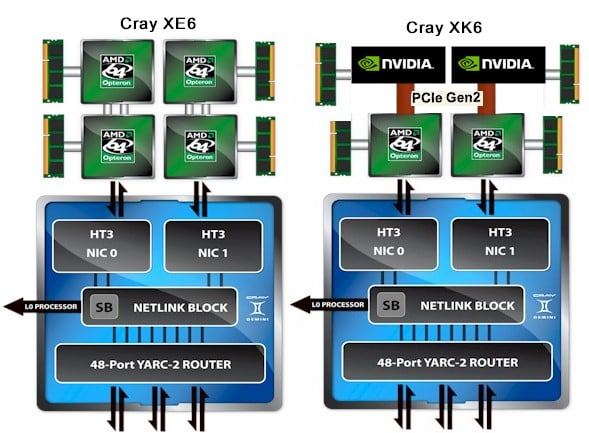Original URL: https://www.theregister.com/2011/05/24/cray_xk6_gpu_supercomputer/
Cray XK6 super mates Opterons with Nvidia GPU workhorses
Ceepie-geepies all around
Posted in HPC, 24th May 2011 17:28 GMT
Supercomputer maker Cray has finally jumped on the GPU coprocessor bandwagon, and it looks like someone is going to have to hitch Belgian draft horses to that wagon and reinforce its axles once the XK6 hybrid super starts shipping in the fall.
Cray made a name for itself as a provider of vector processors back in the 1970s and morphed into a maker of massively parallel x64 machines with proprietary interconnects in the 2000s. With GPUs – whether they are made by Nvidia or AMD – being more like vector engines than not, the adoption of a GPU as a coprocessor is a return to its past. Or more precisely, considering that Cray is really Tera Computer plus Cray Research plus Octiga Bay, one of its pasts.
Cray didn't need GPUs to break through the petaflops barrier, but it is going to need GPUs or some kind of coprocessor to break through the exascale barrier. Barry Bolding, vice president of products at Cray, tells El Reg that "customers are a little dissatisfied that scalar performance has flattened out" in recent years, referring to the clock speeds of the x64 processors used inside of generic supercomputer clusters (usually linked by Ethernet or InfiniBand networks) or the monster machines created by Cray and Silicon Graphics using their respective "Gemini" XE and "UltraViolet" NUMAlink 5 interconnects.
"Cray has not been the first to the GPU party, but we have a very good understanding of petascale applications," Bolding boasted, adding that "putting together a box that has both CPUs and GPUs is the easy part."
In fact, says Bolding, Cray has spent more money on integrating its software stack – a custom Linux environment, its Ethernet emulation layer for the Gemini interconnect, and various development tools for parallel environments – with GPUs than it has spent redesigning the blade servers at the heart of its "Baker" family of XE6 and XE6m machines so they can adopt GPU coprocessors.
"We think that our vector experience helps," Bolding says. "The codes that were good for vectors will generally perform well on GPUs. And we really do view this as a stepping stone to exascale. GPUs are today the most effective accelerator that is available." Bolding added that Cray's future designs will not be locked into either AMD's HyperTransport or Intel's QuickPath interconnects, but rather will hang accelerators off PCI Express links. (Very soon, PCI Express 3.0 links, but not this time around.)
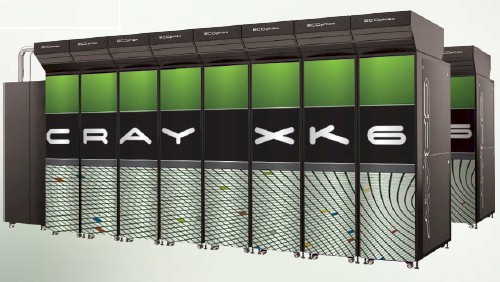
Cray's XK6 ceepie-geepie hybrid supercomputer
The Cray XE6 machines are based on eight-socket blade servers, complete with main memory and two Gemini interconnect ASICs. The prior generation of machines, the XT6 supers, were based on the same "Magny-Cours" Opteron 6100 processors that are used in the XE6 blades, but used the much slower and less scalable SeaStar2+ interconnect. The SeaStar2+ interconnect is the great-grandson of the "Red Storm" interconnect that Cray developed for Sandia National Laboratory, delivered in 2003, and later commercialized as the XT3.
Gemini dream
The Gemini interconnect is a kind of averaging between the SeasStar2+ interconnect used in the XT5 and XT6 machines and a future interconnect called "Aries" that is being created for the US Defense Advanced Projects agency for a series of machines called "Cascade", due in 2013 or so. El Reg walked you through the guts of the Gemini interconnect last May, when it debuted. Here is what it looks like conceptually in the Cray XE6 x64-based supers and how it differs with the XK6 ceepie-geepies announced today:
Cray announced last September that it planned to add GPU coprocessors to the XE6 line, but was a bit cagey about how it would be done beyond using PCI Express links to hang Nvidia's Tesla 20 series of GPU coprocessors off the Opteron processors in its supers. Cray hinted at the time that it was planning on adopting the future "Kepler" GPU cards within the XE6 frames, but never came out and said that. They did say, however, that the GPU coprocessors would link to the CPUs through PCI Express links.
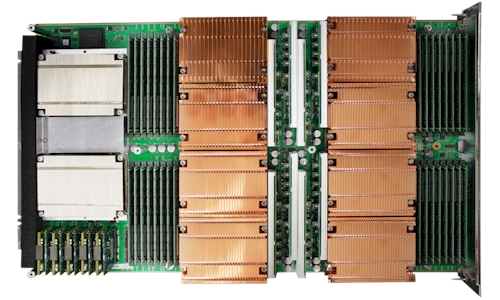
Cray's muscular XE6 blade
The XE6 blade has two Gemini interconnect ASICs on the left (which is the back of the blade), with four two-socket server nodes and their related memory banks to the right of the interconnect.
To make the XK6 blade, Cray took out the four sockets on the right side of the XE6 blade, dropped in four SR5670/SR5100 chipsets from Advanced Micro Devices and four of variants of the new fanless Tesla M2090 GPU coprocessor announced by Nvidia last week. Cray is not using the M2090, but rather a special embedded version of the card called the Tesla X2090, which server makers can buy to put on their own system boards, as Cray has done.
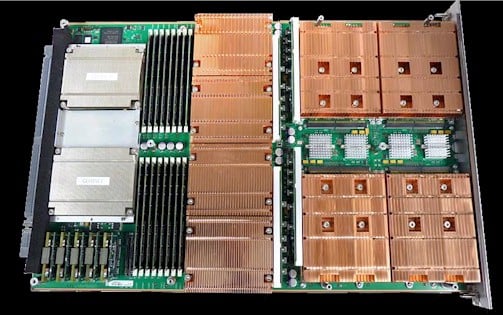
Cray's Tesla X2090–equipped system board
The AMD chipsets are under the aluminum silver heat sinks on the right side of the blade, and the Tesla X2090 GPUs are under the four copper heat sinks on the right side, to the top and bottom of the chipsets. The chipsets implement the PCI Express 2.0 links between the GPUs and the Opteron processors on the left side of the blade. The GPUs have their own main memory, of course – in this case, 6GB of GDDR5 graphics memory. The Opteron portions of the XE6 and XK6 blades have four DDR3 memory slots running at 1.6GHz for every G34 socket. On the XK6, that works out to 16GB or 32GB per two-socket server node using 2GB or 4GB memory sticks.
Technically, Cray does support 8GB sticks if customers want them, and it could go all the way and support 16GB memory sticks, but these are both too expensive for most HPC customers, says Bolding. On the XE6 blade, each of the four nodes has another Opteron G34 socket linked to it over HyperTransport 3 (HT3) links, and has another four memory slots for double the memory capacity.
The Opteron side of the blade is physically identical to the current XE6 blade, but Cray is not shipping the XK6 with the current 12-core Opteron 6100 processors. Rather, Cray will wait until AMD gets the 16-core "Interlagos" Opterons into the field in the third quarter. AMD's wafer-baking partner, GlobalFoundries, is making the Opteron 6200s, as the Interlagos chips will be called, using its 32-nanometer process. AMD interim CEO Thomas Siefert promised Wall Street last month that these chips, which are based on the new "Bulldozer" cores and which plug into the same G34 sockets as the Opteron 6100s, would ship by late summer.
Cray, having been burned by Opteron delays in the past, is only saying that the XK6 will ship in the second half of 2011.
Not waiting on Kepler
As El Reg previously reported, Oak Ridge National Laboratory – one of the US Department of Energy's big nuke/supercomputing labs in Tennessee – had already let slip two months ago that it was building a whopping 20-petaflops machine, called Titan and using a hybrid CPU-GPU design, that would start rolling into its data center later this year with full operation in 2012.
While neither Cray nor Oak Ridge have confirmed this, it is reasonable to presume that Titan is actually an XK6 super. It could also be a variant of it, perhaps with a higher ratio of GPUs to CPUs, which Bolding says will be available through Cray's Custom Engineering unit.
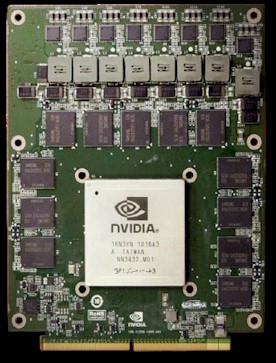
Nvidia's Tesla X2090 GPU coprocessor
Appro International, Dell, HP, and Super Micro have all announced hybrid CPU-GPU racks and blades that have a much higher ratio of GPUs to CPU sockets. More than a few of these vendors have said that, ideally, what customers want is one GPU per x64 core. Bolding says that for now, given the economics of CPUs and GPUs and the lack of workloads using GPUs, a one-socket-to-one-GPU ratio is best for the high-end customers it sells to. (This is the ratio that IBM used in the petaflopping "Roadrunner" Opteron-Cell hybrid machine, the first box to break through that barrier.)
The goal with the XK6 ceepie-geepie blades was to keep the XK6 in the same thermal envelope as the XE6. If Cray could do that, then it would not have to do anything special in terms of packaging or cooling to use the GPUs. Cray met that design goal, and you can pull out an XE6 blade and slide in an XK6 blade and nothing is going to melt, even though the X2090 GPU is rated at 225 watts peak. Companies can mix and match XE6 and XK6 blades in a single system, and Bolding says that many customers will do that so they can support different workloads.
The cabinets used in the XE6 and XK6 supercomputers can house up to 24 blades and have a peak-power rating of over 50 kilowatts as their design point, according to Bolding. That, however, is not how much power they will draw in the field – that will depend on how the applications hit the CPUs and GPUs, of course.
The fact that Cray is waiting for the Opteron 6200 processors for the XK6 and not just shipping this box right now with the current Opteron 6100s suggests that Nvidia is not actually ready to ship the Tesla X2090 GPU in the volumes that Cray needs. (Technically speaking, it has not even been announced yet.) It also suggests that while Cray has confidence in AMD's delivery of the Opteron 6200 processors, the future "Kepler" GPU expected by the end of this year is not going to be ready for whatever time Cray wanted to put it into the XK6 super.
Cray cannot, of course, give out any peak performance ratings on the Opteron 6200 side of the card, but each of the Tesla X2090 GPU cards is rated at 665 gigaflops doing double-precision floating-point operations. Each blade has four GPUs and there are 24 in a cabinet, so that gets you to 63.8 teraflops per cabinet just on the GPU side of the XK6 ceepie-geepie.
The current XE6 blades using the 12-core Opteron 2100s are rated at around 90 to 100 gigaflops per socket, according to Bolding. Add four cores and goose the clock speed a bit on the chips and you might be able to push it up to 160 gigaflops – or at least that is El Reg's guess. That works out to 640 gigaflops of CPU number-crunching power for four Interlagos sockets, which is pretty good compared to the 800 gigaflops that the all-Opteron, eight-socket XE6 blade can deliver.
Add it up, that's somewhere around 3.5 teraflops per XK6 blade of peak floating-point oomph, or something on the order of 83 teraflops per cabinet. With 200 cabinets – roughly the size of the "Jaguar" machine down at Oak Ridge – you are talking about something north of 16.6 petaflops, or nearly an order of magnitude better performance.
With the 3D torus of the Gemini interconnect, Cray can build out as far as 300 cabinets, so a ceepie-geepie super could hit around 25 petaflops. Replace the Tesla X2090s with some Nvidia Kepler equivalents, and a 300-cabinet XK6 super could deliver something on the order of 5.8 petaflops on the Opteron side and 29 petaflops on the Tesla side. You only need something like 15 megawatts of power for that behemoth XK6 supercomputer alone, and maybe 25 megawatts for the whole data center.
The launch customer for the XK6 ceepie-geepie super is not going to be Oak Ridge, by the way, but instead the Swiss National Supercomputing Centre, which is also taking delivery of the first XMT-2 massively multithreaded super, based on the Gemini interconnect and Cray's future ThreadStorm-2 processor.
One more thing: in case you are wondering, the new Cray box is called the XK6 because when they looked at XG6, the font for the G and the 6 looked weird next to each other. ®
